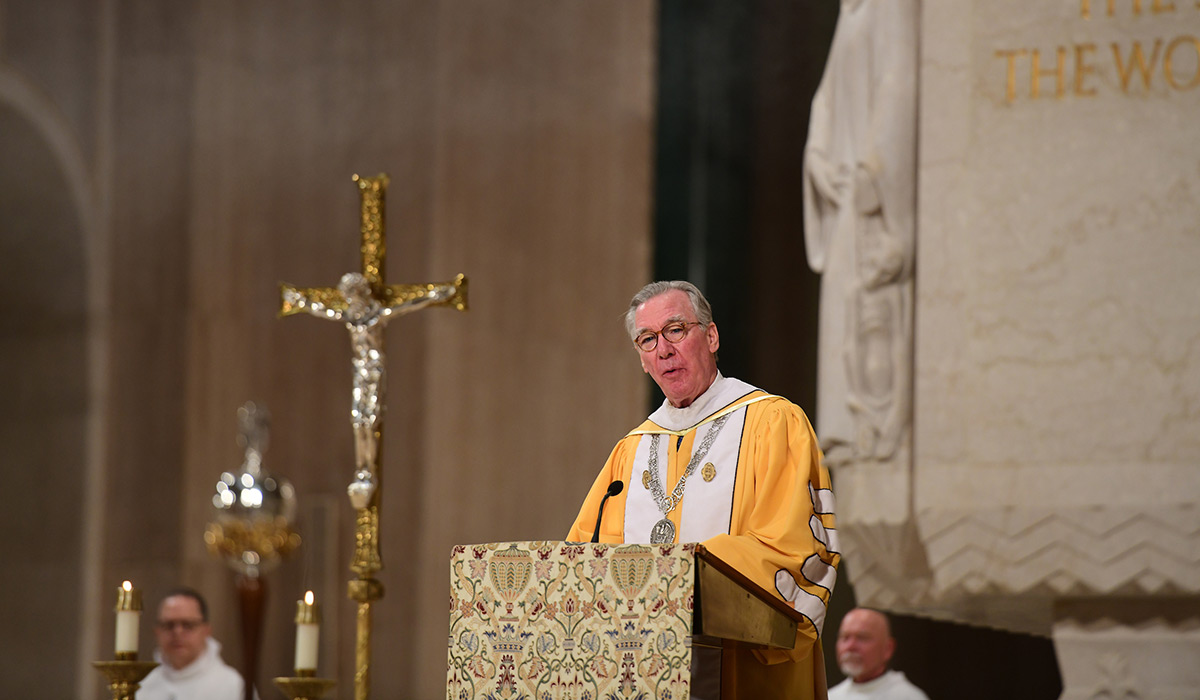

"Purity of Heart"
John Garvey, President of The Catholic University of America
Basilica of the National Shrine of the Immaculate Conception, Great Upper Church
Feb. 4, 2021
According to conventional accounts, the Black Death arrived in Europe in October 1347 aboard several ships that docked at the Sicilian port of Messina. Trade routes quickly carried it across the continent. Over the next four years it killed about 25 million Europeans.
That same year, on the feast of the Annunciation, Caterina Benincasa was born to a cloth dyer about 400 miles away. Northern Italy – Siena, Florence, Milan – was then the economic capital of the world. But the plague hit Siena hard. It killed at least half the population, including two of Catherine’s brothers, her sister Lisa, and several of her nieces and nephews.
The plague caused the local economy to tank. Siena competed with its richer neighbors for artistic recognition. It had begun a great expansion project for the cathedral, built a century before. When the plague hit, the work ended for lack of funds, artists, and labor. Farming outside the city fell off for lack of farm hands. Trade (wool and crafted wares) declined for lack of goods.
Local government was in turmoil. There was an increase in crimes of violence. People sought relief from taxes and rents. To make up for these losses the city claimed the estates of folks who died without close heirs. Scarcity drove up prices, and the city council resorted to wage and price controls. By 1355 the council, a group of nine merchants and bankers, lost its grip on power and collapsed.
Let me add to these difficulties the fact that the Catholic Church was in need of serious reform. Clement V had moved the papacy to Avignon in 1309. The seven popes who resided there, all French, lived lives that resembled those of secular princes. Their example of corruption affected the lower orders of clergy.
Sound familiar – a pandemic, economic troubles, government instability, a Church in crisis? It would be natural for someone born into this turbulent world to let her life be dictated by events. Major shifts like these can control us, the way mountainous seas toss small boats around in a typhoon.
What I love about St. Catherine of Siena is that she steered her own boat, by her own compass, amid all this commotion. She became a third order Dominican, so we can appropriately remember her (along with St. Thomas) on our patronal feast. (She mentions Thomas in her Dialogue.) She is, like him, a mystic and a doctor of the Church, though John Paul II also proclaimed her patron saint of Europe, which might be even cooler.
Unlike Thomas she wasn’t a theologian. The virtue she typifies, the needle on her compass, was singleness of heart, or as we say more often, purity of heart. This is the virtue Kierkegaard writes about in Purity of Heart Is To Will One Thing. It is, St. Matthew says, the virtue possessed by those who will see God.
The one thing St. Catherine willed was union with God. “Let your will, not mine, be done in all things, Lord,” she said. “For I am darkness and you are light; I am not, whereas you are He who is[.]” The stories we read about her fit with this virtue. How she refused her parents’ request that she marry. How she lived on nothing but the Eucharist.1 How at age 21 she experienced a mystical marriage with Jesus, and later his stigmata.
She seems like someone cut out to be a hermit, and that was her wish. Hermits withdraw from the world to avoid its distractions and, like the Cabots, speak only to God.2 That seems like the surest path to purity of heart. But, her biographer says,3 Jesus told her to get involved in the messy, confusing, distraction-filled and complicated life of the world, and so she did. Yet she never took her eyes off of Christ.
She went to work in hospitals and infected homes when the plague returned in 1374. She travelled around Italy advocating reform of the clergy. She began a correspondence with Pope Gregory XI and visited him in Avignon, urging him to return to Rome. (He did.) When the Western Schism occurred in 1378 the new pope (Urban VI) asked her to Rome to plead his case with nobles and cardinals. Through all this time she wrote (dictated) hundreds of letters and her Dialogue of Divine Providence.
There’s a lesson in this for all of us. Hard times should not dictate the course of our lives. Our compass should be God’s will. And we should be cautious about assuming that serving God requires us to withdraw from the world and commune only with him. That is his will for some of us. But purity of heart may ask the rest of us to follow the example of St. Catherine of Siena, who never strayed from her devotion to Our Lord, even while attending the great and small needs of her neighbor.
1 Gregory XI gave her a dispensation to receive communion daily, at a time when frequent reception was rare.
2 And this is good old Boston,
The home of the bean and the cod,
Where the Lowells talk only to Cabots,
And the Cabots talk only to God.
3 Raymond of Capua, The Life of Saint Catherine of Siena 105-107 (2003).